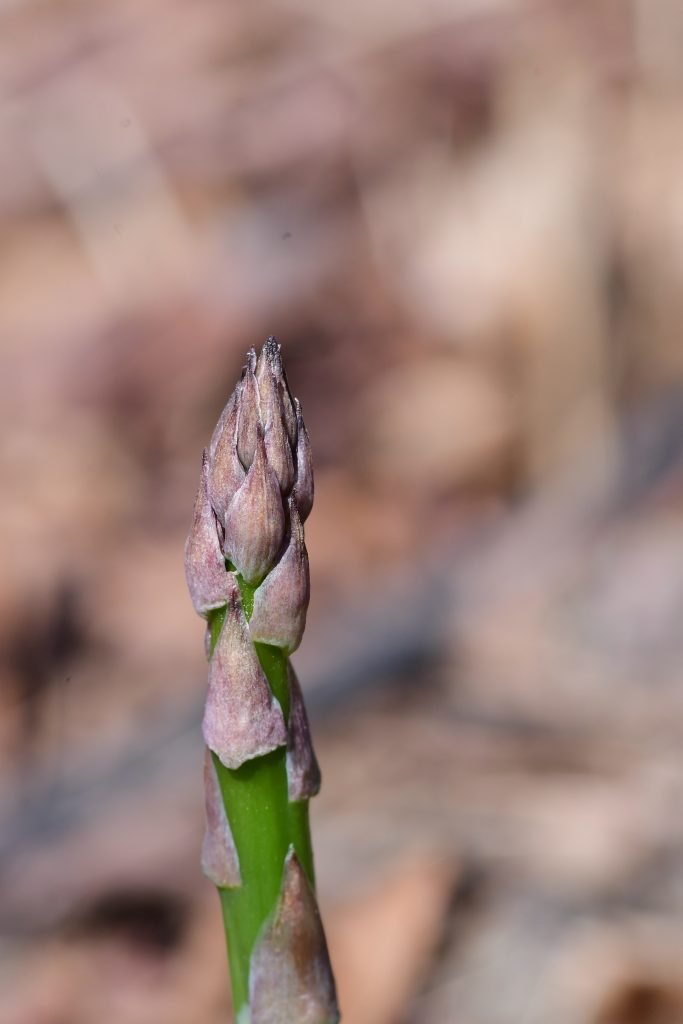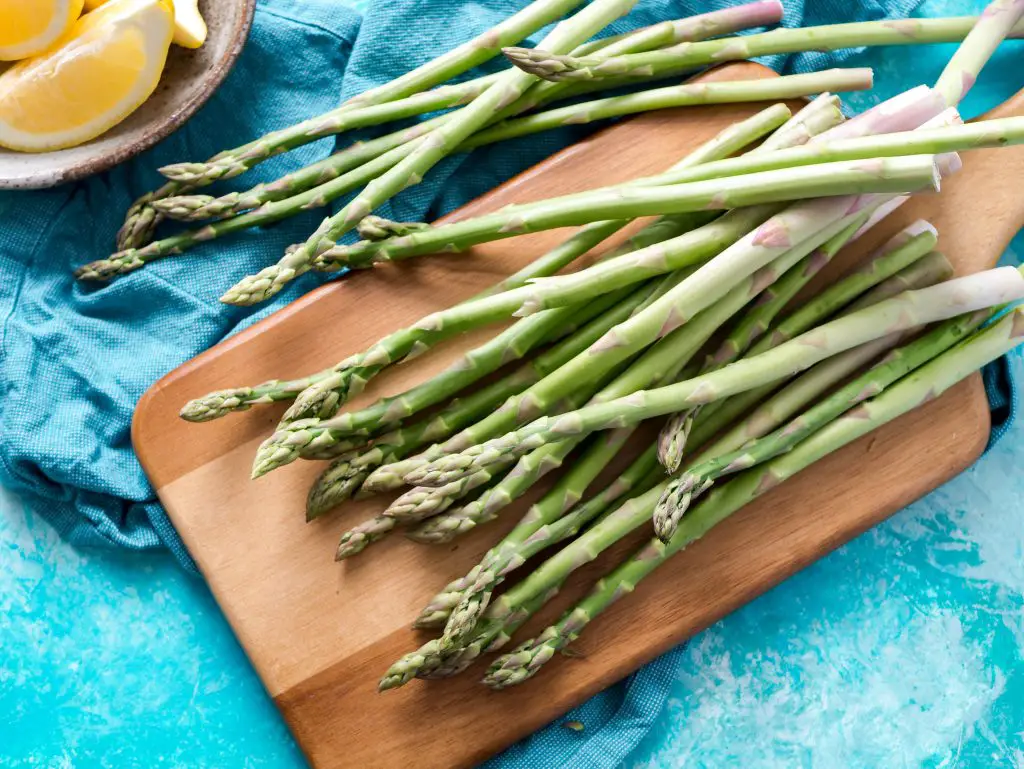How Big Do Plants Asparagus Get? If you love asparagus and want to grow it in your garden one of the key considerations is the selection of a location. But to ensure that they are suitable for that location you must have some idea how big Asparagus plants get.
Asparagus plants typically get to a height of 6 to 7 ft (1.8 m to 2.1 m) they will typically reach this height in Autumn before the plants start to die back. This stage of the growing cycle is crucial for the health of the Asparagus crowns as the growth feeds nutrients into the crowns for the following season. The foliage should only be cut back once it has died back.
When planting Asparagus for the first time it will take around 3 to 4 years for the crowns to produce a worthwhile crop depending upon whether you purchase seeds or one-year-old crowns. In the first few years, the spears produced will be thin and weak and should not be harvested as it will impede the development of the crowns and it will as affect their longevity which is discussed later in the article.
The spacing that is recommended for plants is 2 to 3 ft (60 to 90 cm) within rows and approximately 5 ft (150 cm) between rows. Placing the plants any closer will result in a reduction in the size and quantity of the spears produced.
In What Climates Can Asparagus Be Grown?
Asparagus plants are suitable for growing in Zone 3 to 10 climates. Asparagus is a hardy perennial plant, that will tolerate temperatures as low as -6°C (20°F), and will be productive for approximately 15 years but this can extend to 30 years in some cases depending upon the way the plant is harvested.

What Time Of Year Is Asparagus Harvested?
Once the crowns have reached 4 years old Asparagus plants can be harvested from Early to Mid Spring up until Mid June (in the Northern Hemisphere). However, it is important to note that harvesting spears beyond Mid June is possible as the plant will continue to produce them, but it will have a detrimental effect on the longevity of the plant.
A study carried out by Iowa State University assessed the effect of different harvest dates of Asparagus plants and found that continuing to harvest later into the season affected the output of the Asparagus crowns over an extended period of time. The study showed that when harvesting of the spears continued up until July 15th the quality of the harvest declined year on year and after 5 years the Asparagus spears were no longer considered viable.
When the final harvest was completed on July 1st the overall yield, over an extended period of time, was better. However, after the 6th year, there were indications of declining quality in the spears. So stop harvesting in mid June at the latest.
How Much Does An Asparagus Plant Produce In a Season?
Once an Asparagus crown has reached maturity after 3 to 4 years you can initially expect to harvest around 0.5 lbs (250 grams) per plant. However, as the plant develops over the next 2 to 3 seasons the yield will increase to 1 lb (500 grams) per plant.
During the harvesting period, you can expect that each plant will produce between 2 and 5 spears every 3 to 4 days. This means that to have enough for a meal on a regular basis to need around 15 to 20 plants.
When harvesting the Asparagus it is best to harvest them when they are 6 to 10 inches (15 cm to 25 cm) tall, prior to the flower buds opening. They can be snapped off at ground level, or if you want things to look a little neater an Asparagus knife can be used.
An Asparagus knife, which is designed specifically for the job, cuts the spear just below the ground level. The advantage of this is that it optimizes the length of the spear. The blanched area, just below the ground, is also the most tender part of the spear. An Asparagus knife is not a very expensive item to purchase, to see the latest price on Amazon click here.

How To Grow Asparagus
When growing Asparagus you will need at least 20 plants to feed a family of 4 to 5 people. The preferred spacing of according to Iowa State University, is around 2ft (60 cms) apart within rows and 5 ft (150 cms) between rows. This means that you will require around 130 sqft (12 sqm) of space for your Asparagus plants.
The most cost-effective way to produce enough crowns is to purchase seed rather than one-year-old crowns as they tend to be relatively expensive. When purchasing seeds we recommended visiting Thompson & Morgan’s website if you live in the UK or Seeds for Generations or St Clare Seeds in the US as all these companies have a relatively wide range of seeds available.
When planting Asparagus seeds, it is best to sow them in Spring in modular trays at a depth of 0.5 inches (1 cm). To ensure that you have adequate plants to meet your needs it is advisable to plant double the number of seeds that you think you will need to allow for any failures
Once planted the seedling will take approximately 6 weeks to reach a reasonable size, 4 to 5 inches (10 to 12 cm) in height, before they can be planted into the garden. When planting the seedlings out into the garden it is important to ensure that the temperature is at least 41°F (5°C), though temperatures greater than 50°F (10°C) is generally preferred.
When selecting a location it should be a warm and sunny location that gets at least 6 to 8 hours of sun. Another important consideration is the size of the Asparagus reaches in autumn, as it gets quite large it has the potential to shade other plants out that are growing next to the Asparagus.
To avoid this issue try to select locations that are facing directly South (in the northern hemisphere) to ensure that plants on either side get a reasonable amount of sun at some point during the day. Alternatively, select vegetables that can tolerate shade or even prefer it in hot conditions, examples of this include Lettuce, Spinach, Coriander, or even Swiss Chard.
In terms of soil conditions, Asparagus prefers rich soil with plenty of organic matter, that is moist but well-drained. Ideally, the pH of the soil should be slightly acidic, a pH of 6.5 to 7 is best. To measure the pH of soil it is best to use a pH meter rather than pH kit with test strips. The reason for this that the meter is easily to use, more accurate and cheaper to use in the long run.

The model of the pH meter that we recommend is Sonkir Soil pH Meter because it measures pH, moisture and light.. To check the latest price on Amazon click here.
When planting the Asparagus seedlings they should be spaced 2 ft (60 cm) apart in rows that are approximately 5 ft (150 cm) apart. Water the seedlings in well when planting and ensure that the plant is regularly watered in the first season.
Additionally, as Asparagus seedlings are susceptible to attack from slugs and snails in the early stages of growth it is important to provide them with protection. This can be done by using snail pellets and also using a physical barrier in the form of a cloche. Cloches can be purchased from Amazon if required, however, it is just as easy to use old soft during containers with the bottom cut off and the lid removed.
Once the seedlings become established the crowns underground will develop over the growing season, before becoming dormant in winter. When the plants are dormant they can be dug up and divided into individual crowns and then replanted back into their final position.
In the next 3 Years, the Asparagus crowns will produce very thin spears in Spring, that should not be picked. They should be left as picking them will affect the rate of the development of the crowns. The appearance of shoots will be followed by the production of foliage through the Summer months. The size of this foliage will get progressively larger year on year. Allow the foliage to grow throughout the growing season and do not prune it back. As winter approaches the foliage will die back completely. Once this occurs remove the dead foliage by pruning it back to the ground.
The first harvest can be taken in the 4th year after the seeds have been planted or 3rd Year if crowns were initially purchased. In the first year of harvesting, the yield will be relatively modest, however, once the plants become more established the size of the harvest will improve.
When picking Asparagus only harvest spears up until June 15th to avoid exhausting the crown over time.
If you observe a decline in the quality or quantity of the spears being produced dig up the crowns in the following winter and divide them. You can expect Asparagus crowns to continue to produce, for about 15 to 20 Years if they are looked after.
How To Storage Asparagus
Once you are picking Asparagus regularly it may be necessary to store the spears. This can be best done in a similar way to cut flowers, for a period of about 1 week. To do this start by trimming the bottoms of the spears and stand them up in a glass or jar with about 1 inch (2 to 3 cm) of water in the bottom. Cover the jar with a plastic bag to avoid moisture loss and refrigerate. If the water becomes discolored or cloudy, change the water.
